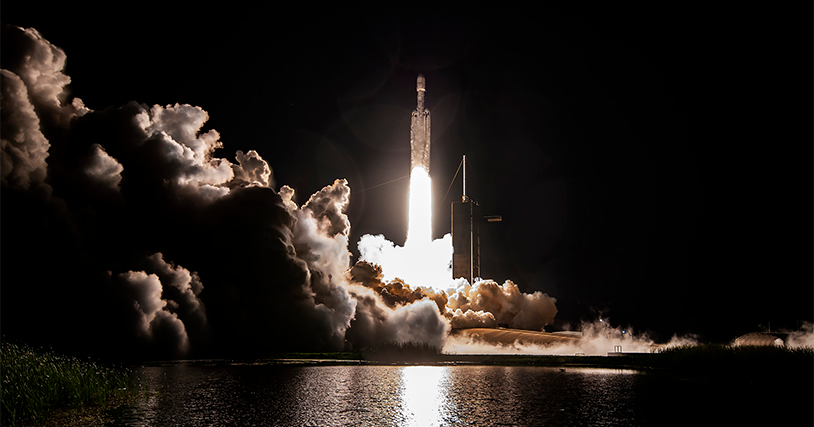
At 11:04 p.m. ET on July 28, 2023, JUPITER™ 3 lifted off from the historic Kennedy Space Center Launch Complex 39A in Florida, illuminating the night sky and sending multiple sonic booms reverberating through the surrounding areas. This groundbreaking launch of the largest commercial communications satellite was years in the making—let’s take a closer look at how we got there.
After arriving in Cape Canaveral nearly a month prior, JUPITER 3 underwent a series of standard tests and health checks, and then continued with the fueling and encapsulation process. Next, it was integrated with the vehicle to prepare for launch. SpaceX’s Falcon Heavy was capable of accommodating JUPITER 3’s size and weight and launches exclusively from Launch Complex 39A at Kennedy Space Center. Fun fact: This launch pad was first used for Apollo rockets that brought astronauts to the moon, as well as space shuttle launches.
Originally scheduled for a July 26 launch, JUPITER 3’s first launch attempt was scrubbed after a stuck valve on the vehicle triggered an abort, but once the valve was replaced and vehicle checkouts were successful, JUPITER 3 was back on track for a July 28 evening launch. Approximately 50 minutes prior to the 11:04 p.m. ET liftoff, propellant loading began.
With about four minutes to launch, the strongback started to retract from the launch vehicle, beginning with the clamp arms opening up from around the vehicle. The strongback is the large structure that is used to roll Falcon Heavy out to the launch pad and raise it into its vertical position. It remains directly next to the launch vehicle until it retracts completely right before liftoff.
About a minute before liftoff, Falcon Heavy entered startup mode, and the internal flight computers took over the countdown process. As the countdown clock reached zero, JUPITER 3 blasted into the night sky, reaching supersonic speeds just after a minute into its flight.
About 2.5 minutes into flight, the two side boosters separated from the center core and started their descent back to Earth and landed at SpaceX’s Landing Zones 1 and 2 in Cape Canaveral to be recovered and flown on future missions. The nighttime double booster return made for some pretty amazing visuals and created multiple sonic booms that could be heard across central Florida.
After separation of the center core, the second stage lit its large Merlin Vacuum engine, the first of three burns during this mission. The fairing halves, which protected the satellite during its ascent, also separated shortly after the spacecraft was safely in space, returned to Earth, and were recovered by SpaceX.
Three hours and twenty-eight minutes after liftoff, JUPITER 3 successfully deployed from the launch vehicle and began sending and receiving its first signals right away, marking a major milestone as the satellite gets closer to its final geostationary orbit. Follow along on our Journey to JUPITER 3 as we continue documenting what it takes to get the satellite into service.